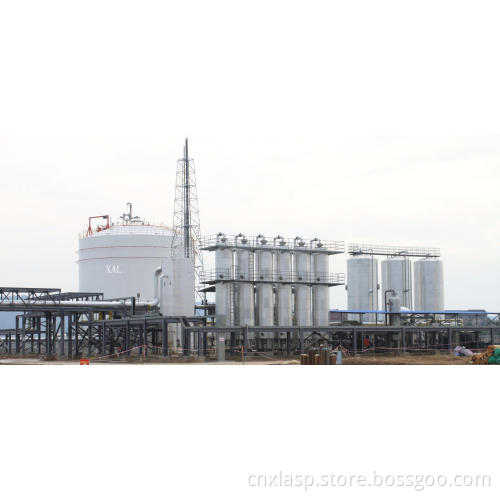
LNG Plant
- Payment Type:
- L/C, T/T
Quantity:
Your message must be between 20 to 2000 characters
Contact NowBasic Info
Basic Info
| Place of Origin: | China |
|---|---|
| Payment Type: | L/C, T/T |
Product Description
Product Description
Purification of NG adopts the complete dry method (using sorbent), compared with the solution adsorption together with MRC process, our dry method together with nitrogen expansion cycle features the following:
1. Low power consumption: Design power consumption is side by side with MRC, but the actual operation power consumption is about 70 percent of MRC process.
2. With inert gas nitrogen as coolant, the plant is safer.
3. Shorter startup time, and quicker restarting after temporary shut down, only 2~3 hours after hot starting, there will be products like full load, the loss of material gas is less.
4. More flexible and adaptable, it can be adjusted within the range of 80%~105% full load (and can run at lower load, but power consumption will rise.
5. Easy operation and control, not limited by composition of NG, and no trouble of changing coolant in different seasons.
6. Basically no leaking risk of flame gas, lower maintenance cost except for power cost.
7. With the imported equipment widely used, higher efficiency, longer service life, and lower labor cost.
8. Adsorption vessel, regeneration tower and many heat exchangers used in wet method are saved, water separation can be combined into the benzene removal system.
9. Nearly ten chemical pumps are saved, such as solution compensation pump, solution distribution pumps, etc.
10. For a 300000 Sm³ /d LNG plant, using dry method can save 600t/h compared with wet method, the vaporized water can be decreased by 18000t per year.
11. Adsorption solution is not used, no trouble of solution tank and solution pollution.
12. BOG can be completely regenerated in dry method, while in wet method, a certain amount of BOG will be consumed.
13. Decarbonization in wet method will cover large area of land, while in dry method, land is saved.
14. Saturated water in material gas after decarbonization will increase working load of downstream systems.
15. In the process of decarbonization in wet method, a part of NG is dissolved in the adsorbing solution and vent into the air after resolved, which causes a large amount of NG loss.
16. In wet method, decarbonization solution pump is often manually operated and with a spare pump, which involved lots of maintenance work and cost. In dry method, automatic switch is achieved. Simplify the operation work.
17. Using nitrogen expansion cycle process, confection and analysis of MRC solution is saved, thus labor cost is reduced(2 operators are enough)
18. Waste water treatment and boiler are saved, thus civil construction cost land coverage is reduced.
19. Most equipment were skid mounted in the Seller's workshop, installation work at jobsite is reduced.
20. To sum up, using our process, the cost for civil work, workshop and installation will saved you several millions compared with wet method.
1. Low power consumption: Design power consumption is side by side with MRC, but the actual operation power consumption is about 70 percent of MRC process.
2. With inert gas nitrogen as coolant, the plant is safer.
3. Shorter startup time, and quicker restarting after temporary shut down, only 2~3 hours after hot starting, there will be products like full load, the loss of material gas is less.
4. More flexible and adaptable, it can be adjusted within the range of 80%~105% full load (and can run at lower load, but power consumption will rise.
5. Easy operation and control, not limited by composition of NG, and no trouble of changing coolant in different seasons.
6. Basically no leaking risk of flame gas, lower maintenance cost except for power cost.
7. With the imported equipment widely used, higher efficiency, longer service life, and lower labor cost.
8. Adsorption vessel, regeneration tower and many heat exchangers used in wet method are saved, water separation can be combined into the benzene removal system.
9. Nearly ten chemical pumps are saved, such as solution compensation pump, solution distribution pumps, etc.
10. For a 300000 Sm³ /d LNG plant, using dry method can save 600t/h compared with wet method, the vaporized water can be decreased by 18000t per year.
11. Adsorption solution is not used, no trouble of solution tank and solution pollution.
12. BOG can be completely regenerated in dry method, while in wet method, a certain amount of BOG will be consumed.
13. Decarbonization in wet method will cover large area of land, while in dry method, land is saved.
14. Saturated water in material gas after decarbonization will increase working load of downstream systems.
15. In the process of decarbonization in wet method, a part of NG is dissolved in the adsorbing solution and vent into the air after resolved, which causes a large amount of NG loss.
16. In wet method, decarbonization solution pump is often manually operated and with a spare pump, which involved lots of maintenance work and cost. In dry method, automatic switch is achieved. Simplify the operation work.
17. Using nitrogen expansion cycle process, confection and analysis of MRC solution is saved, thus labor cost is reduced(2 operators are enough)
18. Waste water treatment and boiler are saved, thus civil construction cost land coverage is reduced.
19. Most equipment were skid mounted in the Seller's workshop, installation work at jobsite is reduced.
20. To sum up, using our process, the cost for civil work, workshop and installation will saved you several millions compared with wet method.
Related Keywords
Related Keywords










